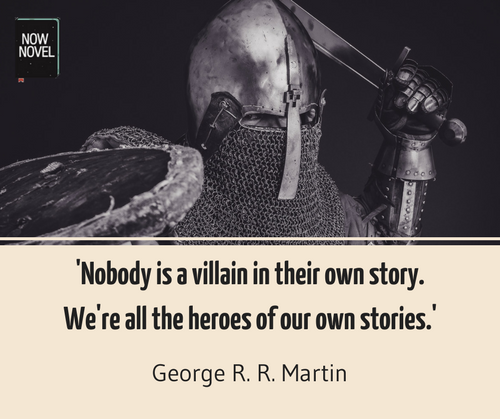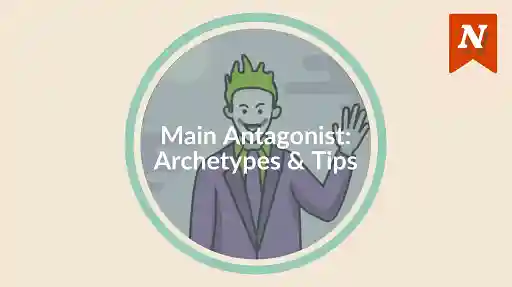In fiction, villains come in all guises and disguises, from scheming rulers to domineering family members or peers. Learn how to write villain motivations that make sense.
For a look detailing what makes a character a villain, an antagonist or an anti-hero, read our in-depth post.
1. Explain villain motivations via backstory
2. Show the power your villain has over others
3. Explain how they get away with villainy
4. Give your villains weaknesses or vulnerabilities
5. Make your villains develop too
6. Summarize famous villains' motivations to learn by example
Let's explore these ideas further:
1. Explaining villain motivations via backstory
Fiction's most complex and interesting villains (like complex protagonists) have backstories.
Shakespeare's Iago from Othello, for example, manipulates his military superior (Othello) to murderous rage. In the course of the play, Iago's motivations are a little vague. Initially, he implies he resents Othello because he passed over Iago for promotion. Later he states he suspects Othello has slept with his wife. These events from an implied past add an essential ingredient of plot: Context. We have context for the villain's actions, rooted in his past experiences.
Other examples of villains' backstories:
- During an epic war, the villain's finger (wearing a magic ring) is cut off, causing him to lose his bodily form and be greatly weakened. He seeks to regain lost power (Sauron in The Lord of the Rings)
- The villain grew up educated and well-read, but has a calculating, miserable nature. He's come to the conclusion that people are happier without being exposed to written ideas (Captain Beatty, the book-burning fire station chief in Fahrenheit 451 by Ray Bradbury)
- The villain has been hired to recover money from a drug deal a man found and claimed for himself (Anton Chigurh in Cormac McCarthy's No Country for Old Men)
In each case, we see the situations and conditions that led to villains' choices within the time of the story.
2. Showing the power your villain has over others
Excessive power is a hallmark trait of villains. Either they pursue it (like Tolkien's Sauron or Rowling's Lord Voldemort) or they have it already and abuse it (like Ray Bradbury's book-burning Captain Beatty). Often, power is a core character motivation.
Villains often gain power over others because:
- Other characters have misplaced trust in them (Othello's mistaken trust in Iago in Shakespeare's play, for example)
- They use verbal and psychological manipulation (Captain Beatty, who manipulates people under his command by cherry-picking quotations from books)
- Villains corrupt others and rope them into their own corruption (Sauron in The Lord of the Rings, who effectively rallies armies by giving others a share of the spoils or the power)
- They use brute force and intimidation (Cormac McCarthy's hired hitman Anton in No Country for Old Men)
Think about the power villainous characters have and what it means. How do they get away with abusing it?
3. Explaining how they get away with villainy
There are all kinds of ways villains in fiction get away with their misdeeds. Some, like Voldemort in the early Harry Potter books, keep a low profile. They have networks of henchmen who help execute plans. These villains only get involved themselves for critical tasks.
Others have powerful privilege or protection. Draco Malfoy in Rowling's fantasy series is a petty and unpleasant secondary antagonist. Yet he has power and status by being from an old and wealthy family with dubious ties to dangerous figures.
Cormac McCarthy's creepy hitman Anton in No Country for Old Men is a survivor. (He survives being hit by a car and merely limps off.) He's also loaded with weapons (a captive bolt pistol and silenced shotgun) and cunning.
Some villains are master strategists. Others are simpler, less brainy, but effectively control and persuade others. Some, like the interfering mother in Nicholas Sparks' The Notebook, have power to make harmful decisions because they are authority figures.

4. Giving your villains weaknesses or vulnerabilities
Like all believable characters, the best villains often have weaknesses or vulnerabilities. Often, because villains are cold, narcissistic, even sociopathic, these weaknesses are physical or strategic rather than emotional.
For example, a criminal drug lord takes an aide at her word, not realizing she's a double agent. Villains' weaknesses may include:
- Underestimating their adversaries
- Important sources of power that are vulnerable because they are extrinsic/external to themselves (Sauron's rings, or Voldemort's horcruxes)
- Physical challenges (a limp, for example)
- Misplaced trust/dependence on others
Villains' weaknesses are important as they help to explain how protagonists are able to overcome them. They provide the small but critical opportunities for the balance of power and conflict in your story to turn.

5. Making your villains develop too
Character development is something we often associate mainly with protagonists. Yet villains risk feeling one-note if there is absolutely no development in their own arcs.
Think about famous villains' story arcs. Some, like Sauron or Lord Voldemort, change physical form over the course of time. This is especially effective when these changes are linked to characters' actions. For example, Smeagol becomes the creeping, beast-like Gollum in Tolkien's Lord of the Rings mythology. This happens because he murders his friend to obtain the Ring of Power. The ring corrupts him over time, a corruption that shows in his appearance.
As villains encounter setbacks or challenges, how do they react? Do they become more violent or dangerous over the course of the story? Are they less careful about hiding their activity (like a killer who taunts the police as they feel increasingly unstoppable)?
6. Summarising famous villains' motivations to learn by example
Summarising famous villains' motivations is a useful exercise for developing your own antagonists. List some of your favourite novels' antagonists. Then summarize their motivations. They might be:
- Greed
- Lust for power
- Violent impulses (stemming from traumatic backstory or other causes)
- Fear (e.g. the desire to protect family or loved ones at all costs)
- False/misguided beliefs (e.g. that X or Y terrible deed is crucial for humankind's survival)
These are just some of the villain motivations you'll come across. Also think about how this affects the story arc. Does a character's greed, for example, cause them to take missteps due to not knowing when enough is enough?
Get feedback on your villains or brainstorm new ones in the 'Character' section on Now Novel.
Cover source image by Daniel Jensen









Thanks for the great tips! I am sitting at my desk now using all your points to strengthen my story's villain.
Todd Mitchell - Over 7 years ago
It's a pleasure, Todd. Thanks for reading. Good luck with your WIP!
Bridget At Now Novel - Over 7 years ago
What could I do if the first book of my series is written and out, but my villain is kind of simple and has no motivation? How can I make him feel more real in book 2?
Oana Văsuţ - Over 7 years ago
I know it's an old comment (and I hope you have found a solution) but maybe someone else reading could use this. If I had this situation, I would make it seem like the simplicity and the lack of motivation of my villain in the first book were intentional. I would use an event from the first book and make it sound like it was the villain's plan all along, thus connecting the first book with the second and raise the scale of his intentions, which, once you make sense out of it, can be a fresh start for you to explain him/her as much deeper than they seemed.
Dado Panda - Almost 5 years ago